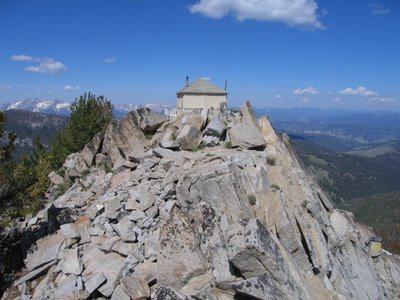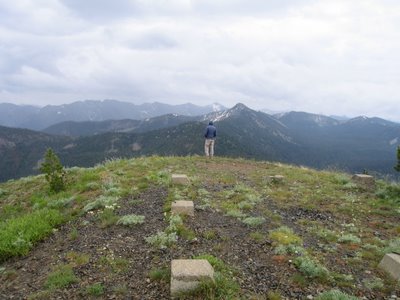Tour de Lookouts






It wasn’t intentional, but our last several outings have been to lookout towers. We did not realize it, but lookouts in the forests of Idaho, and much of the Northwest, are regularly spaced so they are visible from each other, and sit atop many of the highest points. John’s philosophy is, if you want a guaranteed 360° view, why not seek out trails to lookouts? We have come to not only appreciate the views, but also the history of these structures.
Our first one was on Lookout Mountain (9954’) in the region between the Sawtooth and White Cloud Ranges. The name was a bit obvious, but it piqued our interest. This tower was typical of many. Built in the 1930’s but has not been used since the early 1970’s. This lookout was only accessible via a 7-mile hiking trail. Many lookouts from this period were built by labor of the Civilian Conservation Corps (CCC), the work program during the Depression. Designated a National Historical Site, it must be preserved in its original state, but there are often little funds to do this for these remote sites. The lookout is one room, no larger than about 16’x16’, with a walkway all around. The building has large glass windows on all sides, but they were shuttered up. The door was unlocked, and we could look inside. A register for visitors had entries from folks who stayed the night, commenting on the brilliance of the sunrise and sunset.
As we traveled north, we noticed more and more lookouts on the map. We drove to the Pinyon Peak Lookout (9942’), deep in the Frank Church-River of No Return Wilderness. This one was manned by an older gentleman and his equally gentle dog. It was a rainy day, and our host talked of spotting 15 lightning strikes the previous evening. This lookout was the oldest manned lookout in the U.S., dating from 1930, with the log cabin construction of the era. From this peak we could see Lookout Mountain, where we stood just a few days before. The road to get to this lookout transects the wilderness area, often only wide enough for a single vehicle, and following ridges that drop off steeply to either side. We made a grand loop from our camp near the historic mining town of Custer to Stanley on this road. We passed by the former lookout on Sheep Mountain (9192’), with only a concrete foundation and flagpole remaining at the site.
The following day was still overcast, but less threatening. We hiked from our camp to Custer Lookout (9753’). This was another unmanned lookout, but there was plenty of gear inside – cots, kitchen utensils, wood-burning stove, tools. It looked like you could move in tomorrow and start working. Inside was a register, but also paperwork from the early 1970’s, including a fireman’s handbook and a log of a fire observation from 1972.
We traveled further north and camped west of Challis, Idaho. Here we hiked to our most spectacular lookout yet on Twin Peaks (10340’). This is the highest manned lookout currently in the conterminous U.S. Our host here was a young man about 19 years old. He has spent nearly every summer of his life on lookouts with his mother, who worked as a lookout operator, and two younger siblings. This was his first season as a paid employee with a lookout of his own. His mother was working another lookout 100 miles to the north. He welcomed the company, but had his computer chess game and a Fender Telcaster (no electricity, therefore no amp) to occupy his solitary time. We had a blue sky day, the multicolored volcanic rocks of the Twin Peaks caldera all around us. We couldn’t stop looking at the landscape.
Our most recent lookout summit was Medicine Point (8409’) in the Bitterroot Range of Montana. The Forest Service makes some lookouts available for overnight rentals, and this was one of those. For $30 a night you get a propane stove, sleeping pad, forest green gingham tablecloths, and a panoramic view. No one was renting this lookout when we visited, but the shutters were all up and we could look inside. Very cozy.
We have since found the book called “Fire Lookouts of the Northwest” by Ray Kresek in the local libraries where we get Internet access. This book lists all the lookouts in Idaho, Montana, Washington and Oregon, when they were built, elevation, location, and status. But best of all are the stories of the culture of these lookouts and the characters that worked these lookouts in their heyday. We copied a few pages for the areas we plan to travel through, and it has become a bit of a game to find them on the map. We may check off a few more before this trip is over…
The pictures from top to bottom are:
Lookout Mountain, with the Sawtooths in the background,
Pinyon Peak with John discussing geographic points with the host – notice the shutters and rough-hewn wood construction,
Concrete pillars marking the former site of the Sheep Mountain Lookout,
Custer Lookout from a distance,
Twin Peaks Lookout, with an array of solar panels for operation of the radio relay station.
Interior of the Medicine Point Lookout.
Posted using free wi-fi from the public library in Missoula, Montana.

0 comments:
Post a Comment